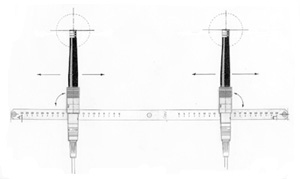
Two spaced omnidirectional microphones creating a stereo image.
The A-B Stereo Technique - or Time Difference Stereo, as it is sometimes called - uses two spaced omnidirectional microphones to record audio signals. The microphone spacing introduces small differences in the time or phase information contained in the audio signals (according to the relative directions of the sound sources). As the human ear can sense time and phase differences in the audio signals and use them for localisation, time and phase differences will act as stereo cues to enable the listener to "capture the space" in the recording, and experience a vivid stereo image of the complete sound-field, including the positioning of each separate sound-source and the spatial boundaries of the room itself.
Microphone spacing
An important consideration when setting up for A-B stereo recordings is the distance between the two microphones. Since the acoustic character of the stereo recording is very much a question of taste, it is impossible to give fast rules for stereo microphone spacing, although it is a good idea to keep some important acoustic factors in mind.
Since the stereo width of a recording is frequency-dependent, the deeper the tonal qualities you wish to reproduce in stereo, the wider your microphone spacing should be. Using a recommended microphone spacing of a quarter of the wavelength of the deepest tone, and taking into account the human ear's reduced ability to localise frequencies below 150Hz, leads to an optimal microphone spacing of between 40 and 60 cm. Smaller microphone spacings are often used close to sound-sources to prevent the sound image of a particular musical instrument from becoming "too wide" and unnatural. Spacings down to 17 to 20 cm are detectable by the human ear, as this distance is equivalent to the distance between the two ears themselves.
It should also be noted, that an increase in microphone spacing will decrease the system's ability to reproduce the signals from sound-sources positioned directly between the microphones. This will also lead to a reduction in the quality of the stereo recording when it is played in mono.
Distance between microphones and sound-source
The ideal distance from the microphone pair to the sound-source not only depends on the type and size of the sound-source and on the surroundings in which the recording is to be made, but also on individual taste. The position from which the listener experiences the event - and hence the position from which the micro-phones record the event - should be chosen with care and feeling.
Critical musical recordings, such as a full orchestra in a concert hall, are good examples of the importance of correct stereo microphone positioning. Here the microphones would typically be placed above or behind the conductor. And although most instruments project their sound in an upwards direction, the microphones should be placed high enough so that the individual musicians do not shadow each other.
The mix of direct and diffuse sound in a recording is also of crucial importance, so much time can often be used establishing the optimum positioning of the microphones. It is here that the versatility of our A-B Stereo Kits comes into play. Using the different acoustical attachments for the microphones, the amount of ambience and the tonal colour of the recording can be adjusted without adding any noise. The choice of floor and ceiling mounting of the boom can give you added flexibility when positioning the microphones.
Omnidirectional microphones and A-B Stereo are often the preferred choice when the distance between microphone and the sound source is large. The reason is that omnidirectional microphones are able to capture the true low frequencies of the sound-source regardless of the distance, while directional microphones are influenced by the proximity effect. Directional microphones will therefore exhibit loss of low frequencies at larger distances.